Are you looking to get the best results from your home's lawn or garden? Keeping your landscape watered correctly is essential, but most homeowners often overlook it.
The correct irrigation system can make a world of difference and help ensure that everything remains beautiful, healthy, and green all season long! In this guide, we'll cover everything there is to know about irrigation systems for homes - from what they are and why they’re needed to how to select the right one for you – so that you can have the perfect garden every summer.
Imagine having a home surrounded by a lush, green lawn and vibrant, healthy flowers in full bloom. This isn't just a scene from a gardening magazine - it could be your reality with the help of irrigation solutions!
Not only do these systems save you from the laborious task of manually watering your plants, but they also conserve water by delivering it directly to the roots where it's needed most. Plus, with customizable settings and schedules, you can ensure your lawn stays nourished even when you're away from home.
So say goodbye to wilted plants and hello to a beautiful, thriving garden with the benefits of irrigation solutions for homeowners!

When it comes to keeping your landscape well-hydrated, choosing the right irrigation system makes all the difference. From drip irrigation to center pivot systems and everything in between, there are countless ways to ensure your plants get the water they need. But not all methods are created equal. Certain types of plants are more suitable for specific landscapes and some use less water and may be more environmentally friendly.
Whatever your needs may be, there's an irrigation system out there that's perfect for you. So why settle for a one-size-fits-all solution when you can tailor your irrigation strategy to fit your specific situation? With so many options available, the possibilities are practically endless.
Imagine never having to worry about watering your lawn or garden again. Well, with automatic sprinklers, that dream can become a reality!
These innovative devices are a game-changer for anyone who loves lush, green lawns and flourishing gardens. Say goodbye to dragging hoses around and trying to hit those hard-to-reach spots.
With automatic sprinklers, you can set precise schedules for when and how much water your grass and plants will receive. Plus, consistent watering ensures that your lawn and garden will remain healthy and vibrant.
Trust us, once you make the switch to automatic sprinklers, you'll wonder how you ever managed without them.
Imagine growing a luscious garden with only a fraction of the water normally required. Drip irrigation systems make it possible to deliver just the right amount of water directly to the roots of each plant.
No more wasted water evaporating in the hot sun or running off into the street. This efficient watering method drastically reduces water usage, while increasing plant health and yield. Plus, with the ability to set up zones and timers, you can easily customize and automate your watering schedule.
Drip irrigation systems can enhance your gardening experience, whether you're a pro or just starting. With this system, your backyard garden can thrive like never before.

Watering your lawn or garden can be a daunting task, especially if you're relying on outdated methods like a hose and a sprinkler. That's where irrigation systems come in!
The components of a modern irrigation system may seem complex at first, but once you understand its different parts, it's a breeze. There's the water source, whether it be a well or municipal water supply.
From there, water is pumped through pipes and into sprinklers or drip emitters, which are precision tools that can water specific plants or areas. And to make sure your system runs efficiently, you'll need a controller that can set different watering schedules for different parts of your landscape.
With the right components, a well-designed irrigation system can make sure your plants get the water they need without wasting a single drop.
No one likes standing in the rain, and your plants feel the same way. That's why an irrigation system with a rain sensor can be so beneficial.
These devices measure rainfall amounts and send a signal to your system controller that shuts off the sprinklers when it detects sufficient levels of moisture in the air. This helps save water and
Get ready to enter the world of smart controllers! These exciting devices are revolutionizing the way we interact with technology. Imagine being able to control multiple gadgets with just one remote. Smart controllers do just that and more.
Not only do they simplify our lives, but they also pack a punch with their impressive features. From touchscreens to voice recognition, these controllers have it all. There's never been a better time to upgrade your home and harness the power of smart controllers.
So what are you waiting for? Join the millions of people already enjoying the benefits of these game-changing devices.

As our planet becomes more and more populated, the demand for food has continued to increase. The fact remains that without irrigation systems to support crops, we would be unable to meet the demands of the world's population.
However, creating and utilizing an irrigation system isn't as simple as it may seem. There are several considerations to take into account, such as the size of the field, the type of soil, and the source of water.
Not to mention, the cost of setting up and maintaining an irrigation system can be significant. But despite these obstacles, it's crucial to implement an effective irrigation system to help feed our growing world and ensure the sustainability of our precious resources.
An important part of any irrigation system is its water flow. This refers to the rate at which water enters and exits the system throughout the day.
Having a consistent, balanced water flow is key for ensuring even watering across your plants. It's also important in maintaining water pressure throughout your system so it can perform properly.
To ensure a healthy water flow, you should set up your system with the correct valves and fittings. You can also adjust the water pressure by using a regulator or backflow prevention device.
By making sure you have the right components in place, you'll be able to maximize the efficiency of your irrigation system and get the most out of your watering.
Soil is an essential component of any irrigation system as it helps regulate the water flow and ensure proper absorption. Different soil types have different properties that affect how they interact with water and nutrients.
For instance, sandy soils are known for having low moisture retention and nutrient levels but excellent drainage. On the other hand, clay soils are known for having high moisture retention and nutrient levels but poor drainage.
Knowing the type of soil you have will help you determine the kind of irrigation system you should set up to get the most out of your water and fertilizer use. With this knowledge, you can design an irrigation system that is tailored specifically to meet the needs of your landscape.
The climate is always on our minds, especially with the unpredictable weather patterns that have been occurring recently. It's important to understand the impacts of climate change and make conscious decisions to reduce our negative impact on the environment. But it's not all gloom and doom - there are plenty of initiatives and technologies being developed to help combat climate change. From electric cars to renewable energy sources, it's inspiring to see the progress being made toward a more sustainable future. Let's continue to educate ourselves and take action to protect our planet. We all have a role to play in preserving the precious natural resources that make our lives possible.
The demand for water resources is growing every day, and it's important to use them as efficiently as possible. Irrigation systems have become much more efficient in recent years, with the help of new technologies like soil sensors and controllers.
These devices are designed to monitor moisture levels in the soil and adjust watering accordingly. By using these technologies, you can ensure that your irrigation system is using no more water than necessary and maximizing its efficiency.
You can also save energy by installing an efficient pump and making sure all components of the system are properly sealed to prevent leaks. By following these steps, you can make a meaningful contribution toward conserving our precious water resources.
Are you tired of constantly worrying about whether your plants are getting enough water? Planning an irrigation system is the solution to your problems!
With a well-designed irrigation system, you can ensure that your plants receive the right amount of water consistently. Say goodbye to overwatering or underwatering your plants. Instead, sit back and relax while your irrigation system takes care of their watering needs.
Not only will this save you time and effort, but it will also result in healthier, more vibrant plants. So why wait?
Start planning your irrigation system today and take the first step towards a greener and more beautiful garden.
Once you’ve decided on the type of irrigation system that will work best for your landscape, it’s time to start measuring for installation.
First, determine your water supply source and measure its flow rate. This will help you figure out how much pressure is available and select the appropriate components.
Next, measure the area you need to cover. This will help you decide how many sprinklers or emitters you need and where they should be placed. Finally, plan out the pipe layout for connecting your irrigation components.
With careful consideration and accurate measurements, you can be sure that your irrigation system is installed correctly and delivers water effectively to all areas of your landscape.
It’s important to set up a watering schedule that fits your landscape and irrigation system.
This will help you ensure that each zone gets the amount of water it needs at the right time. You might also consider scheduling your watering during cooler parts of the day, when the sun isn’t as strong, and more water will be absorbed into the soil.
If you’re using a programmable controller, you can easily set up your watering schedule and make adjustments as needed. Otherwise, you can use an app or other digital tools to help manage your irrigation system.
By having a well-thought-out watering plan in place, you can be sure that your plants get the right amount of water each day and that you’re conserving this precious resource in the process.
Searching for the right irrigation contractor to bring life to your outdoor landscape can be a daunting task.
But fear not! The perfect contractor is out there, waiting to turn your dream project into a reality. When hiring an irrigation contractor, it's important to do your research and ask the right questions. Find someone with experience and knowledge in watering systems that suits your specific needs and preferences.
They can help determine the best irrigation design for your landscape and ensure proper installation and maintenance. Don't settle for less than the best, and watch as your lawn and garden flourish under the care of a trusted irrigation contractor.
If you are in Whatcom County contact Puget Construction & Landscape for your irrigation project!

There are various types of irrigation systems available including automatic sprinklers and drip irrigation systems, which each have their own unique components.
When planning an irrigation system, it is important to consider how water flow, soil, climate, and energy will be affected by the installation of a system. Understanding these aspects will help in determining the right type of irrigation system as well as measuring and calculating the amount of water needed for proper performance.
Lastly, hiring a professional contractor can ensure that all elements of creating a properly functioning system are accounted for easily. Investing in an irrigation system not only provides you with peace of mind but also offers numerous benefits now and in the future.
Get Your Irrigation Project Started With Puget Construction & Landscape
By the time the cold of winter passes, people are itching to get outside. After a season of turning in, one of the best things you can do is create an outdoor space that beckons you out of doors.
The yard is actually an outdoor extension of your home, which means it deserves as much care and intention as the inside. As you prepare to leave the dark of winter behind you, consider taking on a spring landscaping project that will help you create an outdoor space that you love.
Before you plan a landscaping project this spring, there are some things you will need to consider. The last thing you want to do is decide upon a project that you won’t be able to undertake for whatever reason. Instead of diving right into planning your project, take some time to think about these important aspects:
It’s important to figure out your budget before you plan any landscaping project. You’ll need to understand what you can afford in order to design your custom landscape. Consider factors such as the size and detail that you’re looking for, as well as whether you’ll be hiring a landscaper or going for DIY. Write out the desired details of your project, your projected costs, and the max amount you want to spend before you create your plan.
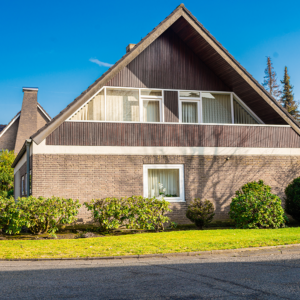
Before you get started on your landscape plan, think about the types of features that you want in your outdoor living space. Make a list of what you desire the most, so that you can do your best to fit your wants into your budget. Consider what you want to be doing outside during your spring and into the summer, and choose some features that will help you.

When you are choosing plants to include in your landscape, don’t forget that they are going to grow. Plants that you purchase typically come with growth requirements, so you can make sure that anything you buy is going to fit in your space when it reaches maturity.
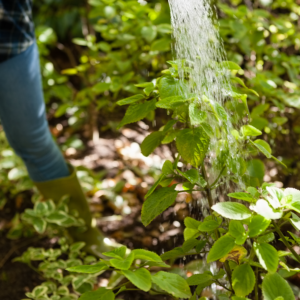
Another important consideration is future maintenance. Any landscaping that you do is going to require regular care and maintenance, including weeding and watering. Before you begin your landscaping project, ensure you’re going to be able to provide the proper care to keep your yard in great shape.

Now that you’ve figured out some of the basic details of your spring landscaping, it’s time to find a project that meets your needs. Here are some of the top spring landscaping ideas to inspire your creative juices:
Mulch is an easy and affordable way to add some nice variation to your yard with a bit of texture and a pop of color. Mulch comes in a number of colors, allowing you to choose your color contrasts. Dark roast, cedar-toned, black, and red are all typical colors of mulch that can add the change you’re looking for this spring.
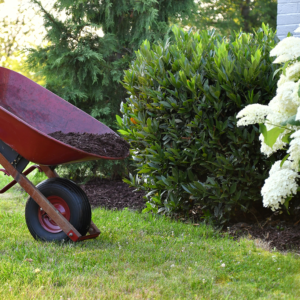
Planting a tree is a great way to add something new to your spring landscape. Even just adding one single tree creates a big change to your yard. Trees provide value to your yard, especially as they mature. They are fairly low maintenance and there are numerous options to choose from. Pay attention to your local climate, as well as the colors and textures you want your yard to have, when you are deciding on the right tree for your landscaping project.
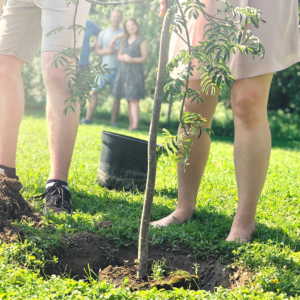
Planting seedlings is an easy project that the whole family can do. Buy the seeds of shrubs or perennials to plant something low-maintenance, easy to care for, and that will provide a beautiful spring landscape for years to come.
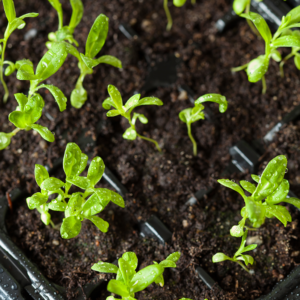
Adding some edging along your lawn or garden beds is a desirable way to change the look of your yard, as well as to provide a simple means of maintenance to the growing plants within. You can purchase pre-made edging or use some creativity to create your own. Another edging option is to plant some easy to care for plants along the border of your walkway, such as lamb’s ear or lily of the valley.
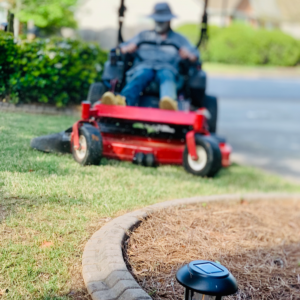
Spring is the time when the world awakens. Your yard is ready to awaken as well.
Get your outdoor living space ready by choosing a spring landscaping project that meets your needs and helps you create a yard you love.
The fall season is here, meaning the changing colors and falling leaves. Fall is a beautiful and majestic time, but it also means greater effort and activity to keep your yard clean and presentable. Cleaning yards is a simple task and can be made extra quick and effective with these tips and tricks.
It can be nice to look at fallen leaves as they pile onto your yard, but you should always be sure to clean leaves frequently during the fall months. It can be tempting to leave big, beautiful piles under trees and in your yard, but these can have long-lasting and unforeseen effects on your home and yard. For example, leave piles and other debris like felled branches make great homes for pests of all sorts, like fleas and other insects.
These critters also love to root themselves within flowerbeds, especially rose beds, because the foliage of these plants acts as a home for the disease. Over the winter, bugs and other insects love to nestle in mounds of dead leaves and other plant life, so be sure to remove all the debris you can see when the fall months come.
" Regular yard care is required to help maintain your lawn and ensure it can bounce back from things like bad weather conditions, weeds and infestations of insects and diseases. "
Once fall hits, the final harvest is upon you. Take advantage of this time by removing your vegetables for the last time then removing debris and cleaning your garden. Unbeknownst to many, an additional layer of compost before the winter can help with new growth and foster health for plants to grow in the spring and summer seasons. Additionally, composting can keep your soil from degradation and other negative effects of the winter weather, such as freezes and reduced sunlight.

Fall is often when branches start to wither and die. These should be handled immediately to insure your house and cars are safe from falling damage. Many branches thrive during the summer and don’t need to be worried about, but it’s a different game in the winter. Branches should be pruned back to discourage overgrowth and an unhealthy weight. Additionally, the vibrancy and overall health of your branches will be improved by maintaining proper care of your trees, including pruning, proper watering, and composting if need be.

Gutters are an overlooked but highly important piece of the yard safety process. Debris can pile up quickly and easily in your gutters, causing damage from additional and unnecessary weight. This weight, in turn, can cause damage to your gutters even the structural integrity of your roof.
In addition, you should never purchase gutter guards, as these usually mean additional costs in both cleaning and maintaining your gutters. Give your gutters a thorough clean to remove all debris and ensure there are no blockages stopping rain or other water sources from cleanly exiting your roof and transferring to the ground.
" When gutters and downspouts become clogged with debris, the water doesn’t magically go away. Instead, it can stay in place, eventually causing the gutters to sag or even detach from the house. Overflowing water causes trouble as well. "
Most don’t think twice about leaving their wet or water-based equipment out over the duration of winter, but this can be a costly mistake. Rainwater and internal moisture in these pieces of equipment can cause damage, as ice can cause stretching and cracking, and overall degradation.
To ensure your equipment is safe from the ravages of ice and other harsh elements during the winter, you should take care to dry out hoses, fountains, and drip irrigation systems. Once you’ve ensured your equipment is dried out, you should store the equipment in a dry place, safe from the elements, and untouched by the ravages of winter.
" Mowers are replaced every six years, on average, according to the Outdoor Power Equipment Institute, an industry trade group. But yours can last much longer than that with the right care. "
Aeration, breaking up the soil to prevent water from pooling, is a great way to avoid costly disasters at your house during the winter months. Aeration also provides key nutrients to your plants which will reach all the way down to the roots during the winter.
This process increases the likelihood that your plants will stay alive and be ready to thrive during the spring and summer months. Performing aeration doesn’t take any fancy or expensive equipment; rather, all you’ll need is a garden fork for small yards or a walk-behind aerator for larger yards. These should be available for rent from retail stores and online for a modest price.
" Almost all lawns will benefit from aeration, and a great lawn demands it. "
The key to having a yard that you can tend to and admire when winter is over is to feed it during the fall and winter months. Providing your lawn with essential nutrients is a great way to keep it healthy and long-lasting during your lifetime. The best fertilizers will contain a high amount of phosphorous which aids root growth and which will make your lawn lush, soft, and green in the spring.
Additionally, it’s always a great idea to rake your lawn early and often, as fallen leaves can easily suffocate your grass. As you rake, you can also mulch your plants and flower beds with the shredded leaf particles. You can even buy a mulching lawn mower for the most effective and quickest results imaginable.
" There are only three letters you need to know to have a high-quality lawn: NPK. These three letters represent the three main macronutrients for lawn care, Nitrogen (N), Phosphorus (P), and Potassium (K). "
The great part about a winter lawn is never having to mow, but you should ensure your soil dries out quickly in the spring. To do this, set your mower to its lowest setting and give your lawn one more fresh, close buzz before winter arrives. Enjoy the feeling of the crisp air as you mow one final time before the cold fall air officially kicks in.
Once finished with this, you can start protecting your plants which may be more sensitive to the cold environment. Perennials, shrubs, and roses can’t survive well in the winter, so do everything in your power to keep them safe. Add mulch to the base of the plants and wrap them in cloth barriers to help prevent freezing. The amount of wrapping should be determined by how hardy your plants are to the cold; plants that are more sensitive should be wrapped in multiple blankets, but tough plants will only require one.

Finally, the last steps you should take to ensure a smooth and safe transition through winter and into summer is to cover your deck and make sure your tools have been safely stored away. Mold and mildew can grow rapidly during the winter months, but they can be easily prevented with a good power washing on your deck.
A nice weatherproofing stain will ensure cleanliness through the winter and into the spring. You should also clean your gardening tools, rather than simply throwing them into the shed and forgetting them until the spring. A nice, thorough wash will prevent rust and keep them durable for longer.
The fall and winter months can be a nice break from the weekly routine of maintaining your garden, but there are a few steps you should take to ensure a safe and clean environment for the spring to arrive. Wash and clean your tools, prune your dying trees, and make sure your lawn is cut and cleaned of any debris which could harbor pests and suffocate your leaves.
You don't have to take on all of the above tasks yourself! Puget Construction & Landspace can keep your lawn looking great throughout the whole year!
It’s a question just about every homeowner faces at some point: Do I take care of my lawn and landscaping on my own, or do I hire a professional service?
Now, it’s of course our opinion that you’re better off going with a pro like Puget Construction and Landscape (PCL), but let’s take a fair look at the pros and cons of both options, and by then we hope we’ll have made a convincing case.
Saving money is the #1 reason people give for taking care of their lawns on their own. Are the savings really true? We’ll go into this some more later, but it’s true to an extent that you can save money if you do it yourself. However, this applies primarily to very small yards and to lawns where the approach is a basic one. Regarding the latter, though, lawn care can get a lot more complicated and time-consuming than just mowing the lawn and pulling some weeds.
Exercise is another reason people cite. It’s no secret that many Americans don’t get enough exercise, and pushing a lawnmower back and forth across a yard for a few hours on a Saturday morning is certainly a way to break a sweat, elevate the heart rate, and burn some calories. And it’s convenient; no trips to the gym or a local park are necessary. We have no argument about any of that.
If you’re doing lawn work yourself, you might also be seeking some much-needed “me-time.” That, too, is something we can’t argue with. The only thing we want to point out is that with a professional lawn service, you can enjoy that “me-time” in a lot of other places and ways.
People who like to do projects themselves usually get a lot of satisfaction out of doing the work and take a lot of pride in the finished product. That’s understandable and commendable, but it also presupposes they’re going to do a good job and the results are the ones they expected.
There’s a reason lawn-care experts undergo specialized education and training: lawn care is a science. If you aren’t an expert, you might not end up with what you hoped for. In fact, you might even cause damage to the lawn.
That brings us to hidden costs. If you make mistakes that harm the lawn, they can be costly to fix. Also, since there’s more to lawn care than just mowing and weed pulling, you also begin to realize it costs you more and more to buy the equipment and the materials that you need.
The biggest con of DIY lawn care, however, is the time expenditure. Lawn care done properly is not something you can knock out in a few hours each weekend; it actually requires several hours on a weekly basis for one person even if that person has the tools and know-how necessary.
There are several clear benefits of hiring a professional service for your landscaping needs.
When a pro like PCL is taking care of things, you have the peace of mind from knowing that certified experts are in charge. They know what to do, how to do it, and when to do it. Moreover, they will do it right the first time.
Knowing that a certified, insured pro is taking care of things also relieves you of the headaches that might come from messing the job up yourself and facing costly fixes. In the rare event that a reputable service does make a mistake, they’re going to make things right.
Something almost everyone can agree on is that there’s never enough time to do the things you want and need. While some people genuinely do enjoy working in the yard (Who are we to judge?), most people don’t, and a lawn-care company will free up some valuable time you’d probably rather spend doing something else. Plus, it’s easy on you because you don’t have to be home when we show up, there’s a regular schedule you can depend on, and you can sign up for automatically renewing plans so you don’t have to worry about service lapses.
Previously, we mentioned that the idea of lawn care being just mowing grass and yanking out weeds is a misconception. Consider this list of other landscaping-related needs that would add to your time and expenses if you were doing them all yourself: edging and trimming, leaf removal, pruning shrubs and trees, fertilization, aeration, reseeding, pest/weed/fungus control, and more.
The time and money required to keep up with your lawn’s needs really add up over time, and then there are the concerns about doing things wrong and causing costly harm.
Did you know that the prime times to fertilize and treat for weeds sometimes overlap? Doing both at once can kill the growth you want unless you really know what you’re doing. Did you know that areas damaged by insects often look like drought damage? Fertilizing, watering, and reseeding when the diagnosis was wrong might only benefit the insect pests. Do you know what the proper cutting lengths are for the grasses in your region by the season? Cutting too low for the season can weaken the grass and kill it, inviting weeds to take over.
Mistakes like those drive up your costs over the long run. Even without those mistakes, you save money over time because professional services can spread costs over their multiple clients, thus bringing down individual costs for all.
People with allergies, heart conditions, respiratory conditions like asthma, and other health concerns can be at risk when doing lawn care on their own. For some, it can literally be a matter of life and death. If you’re in any of those categories, entrusting the work to someone else makes a lot of sense.
Maybe you’ve had a neighbor with an unsightly lawn, overgrown and/or infested with weeds. Maybe you’ve even been that neighbor at one point! Either way, you know the tensions that can arise when homeowners worry about the aesthetic appeal of their neighborhood and the effects on property values. Nice lawns make nicer neighbors.
Finally, credible studies by realtor associations show that on average, homes receiving professional lawn and landscaping care tend to have higher resale values than comparable homes that don’t. The higher curb appeal also makes it more likely a potential buyer will decide to come in to see the interior. Even if you’re not selling, you still benefit from higher satisfaction; studies also show that people with great lawns enjoy being outside on their properties more.
There’s the additional cost, but we’ve already shown that over time, professional lawn care is less expensive than a DIY approach is.
The other is making a bad choice of provider. Unfortunately, there are companies that do shabby work and even leave a lawn in worse shape than it was in before, sticking you with the repair bills. But that’s easy to avoid with a little homework, and today’s online world makes it a lot easier to research a company than it used to be.
PCL is a leading landscaping and Bellingham lawn-care company serving Bellingham and Whatcom County.
We offer different service packages for different budgets and needs. No matter which one you choose, you’ll get the very best value for your money.
To get a quote or learn more, just contact us today!